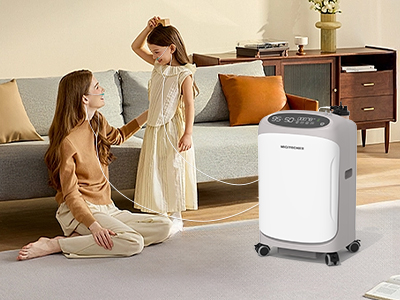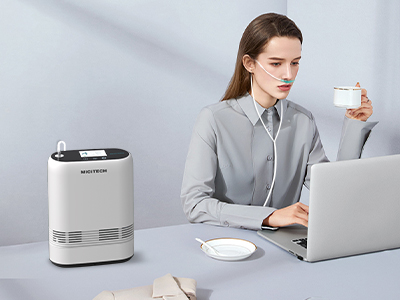14 Oct 2024
Over the years, oxygen therapy has evolved significantly, with new technological advancements enhancing both the efficacy and convenience of oxygen delivery systems. As healthcare moves toward more patient-centric care, these innovations are revolutionizing the way oxygen therapy is administered, offering patients better quality of life.

Traditional Oxygen Therapy Equipment
In the early days of oxygen therapy, oxygen cylinders were the primary means of delivering supplemental oxygen to patients. These large, heavy tanks were effective but came with a host of limitations, including limited portability, the need for frequent refills, and difficulty in managing oxygen flow for long-term users.
Oxygen concentrators, which emerged as a significant breakthrough, allowed patients to access a continuous oxygen supply by filtering and concentrating oxygen from ambient air. While early versions of concentrators were bulky and not particularly energy-efficient, they marked a pivotal step forward in oxygen therapy equipment.
Portable Oxygen Concentrators
The introduction of portable oxygen concentrators (POCs) has transformed the lives of patients who require long-term oxygen therapy. Unlike traditional concentrators, POCs are lightweight, battery-powered, and designed to provide oxygen on the go. These devices have given patients unprecedented mobility, allowing them to maintain active lifestyles while managing their oxygen needs.
Modern POCs come with a range of advanced features, including pulse and continuous flow settings, rechargeable batteries, and compact designs that make traveling easier. This mobility has empowered patients to enjoy activities outside the home without the worry of running out of oxygen or carrying bulky equipment.

High-Flow Oxygen Therapy Devices
High-flow oxygen therapy (HFOT) represents a significant advancement in oxygen delivery, particularly for patients with more severe respiratory conditions. HFOT systems deliver oxygen at higher flow rates than standard devices, ensuring that patients with critical oxygenation needs receive adequate therapy.
The devices used for high-flow oxygen therapy are designed to maintain precise oxygen concentrations and humidity levels, making them especially useful for patients with acute respiratory failure or severe chronic obstructive pulmonary disease (COPD). This technology has proven essential in hospital settings and is now making its way into home care environments as well.
Smart Technology in Oxygen Equipment
In the era of digital health, oxygen therapy devices have benefited from the integration of smart technology. Many advanced oxygen concentrators and portable systems now come equipped with AI-driven features and Internet of Things (IoT) connectivity. These innovations enable real-time monitoring of oxygen saturation levels, device performance, and patient activity.
By leveraging smart technology, healthcare providers can remotely monitor a patient’s oxygen usage and adjust settings as needed. This not only ensures better management of chronic conditions but also improves patient compliance and overall outcomes./p>
Improved Oxygen Masks and Cannulas
The comfort and efficiency of oxygen delivery are critical factors in ensuring patients adhere to their prescribed therapy. Recent innovations in oxygen masks and nasal cannulas have focused on improving comfort, reducing irritation, and maximizing oxygen delivery efficiency.
Modern oxygen masks are designed with softer, more flexible materials that conform to the patient’s face, ensuring a better fit and reducing discomfort. Likewise, nasal cannulas have been refined to minimize pressure on the nostrils and reduce the risk of skin breakdown. These seemingly small adjustments have a significant impact on patient satisfaction and therapy effectiveness.
Oxygen Therapy in Home Healthcare
The shift toward home-based healthcare has been another key factor driving advancements in oxygen therapy equipment. Patients with chronic respiratory conditions are increasingly managing their oxygen needs from the comfort of their homes, thanks to portable oxygen concentrators and telemedicine capabilities.
Remote monitoring systems allow healthcare providers to track a patient’s oxygen levels, device usage, and overall health metrics in real-time. This allows for early intervention when oxygen levels fall below safe thresholds or when equipment issues arise. As a result, patients experience fewer hospital visits and enjoy greater independence in their care.
Future Trends in Oxygen Therapy Equipment
Looking ahead, the future of oxygen therapy equipment promises even more groundbreaking advancements. Miniaturization of devices will continue to make oxygen concentrators and related equipment smaller, lighter, and more discreet, allowing patients to carry them without discomfort or restriction. Additionally, battery technology is expected to evolve, leading to longer-lasting portable oxygen solutions.
Another key trend will be the increased use of artificial intelligence and machine learning algorithms to personalize oxygen delivery. By analyzing patient data, AI-powered systems will be able to predict when oxygen levels need adjustment based on activity levels, health status, and environmental factors, providing a fully tailored oxygen therapy experience.
Conclusion
Oxygen therapy equipment has come a long way from the heavy, stationary devices of the past. With innovations like portable oxygen concentrators, high-flow oxygen therapy systems, and smart technology, patients now have access to more efficient, comfortable, and flexible options for managing their oxygen needs. As technology continues to evolve, the future of oxygen therapy holds exciting possibilities for enhancing patient care and improving quality of life.
Keywords: oxygen therapy
Originally published 14 Oct 2024, updated 14 Oct 2024.